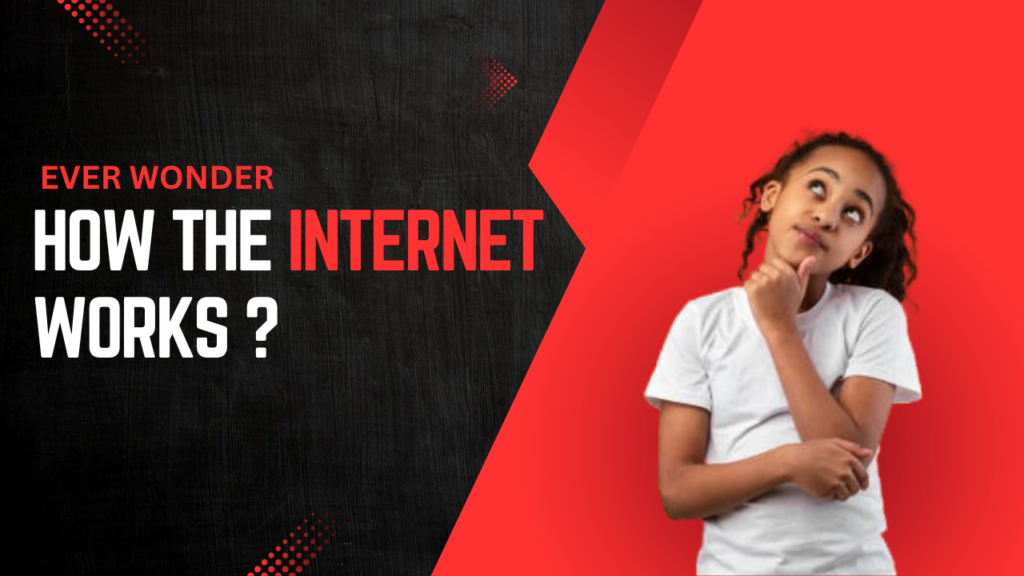Introduction
Every day, you use the internet. You watch movies, browse social media, chat with friends, and shop online. However, are you really aware of what happens in the background when you type in the name of a website and press Enter? Let’s make it simple so you can finally understand how this invisible network works.
What is the Internet?
A Global Network Explained
The internet is a massive global system that connects billions of devices, from smartphones and laptops to servers and satellites. Think of it as a huge web of roads, where instead of cars, information travels at lightning speed.
Internet vs Web
Many people mix up the internet and the web, but they’re not the same. The internet is the actual network made of cables, routers, and servers. The web is only a part of it, which includes the sites, apps, and online content you use every day.
Why is the internet so important in daily life?
Simple. Without it, your smartphone would only make calls and send texts. No YouTube, no WhatsApp, no Google Maps. Work would slow down, learning would suffer, and staying in touch would feel like going back decades.
Step-by-Step: How the Internet Works
Step 1: You type a website
When you type something like google.com into your browser, your device sends out a request to reach that site.
Step 2: Finding the address
Websites are stored using numbers called IP addresses, not names. The Domain Name System (DNS) works like a phonebook. It takes the name you typed and matches it with the correct number.
Step 3: The request travels
Your request moves through several routers. These routers guide the data along the fastest path. In just a few milliseconds, the request may cross different cities or even countries.
Step 4: The server replies
When your request arrives at the website’s server, it collects the files you need, like text, images, or videos, and sends them back to your device.
Step 5: Data Packets Reassemble
The information doesn’t come back as one big file. It’s broken into small packets. Each packet takes the fastest path to your device. Once they arrive, your browser pieces them back together into the full website.
Key Components of the Internet
ISP (Internet Service Provider)
This is the company that connects you to the internet, like PTCL in Pakistan, or Comcast in the US.
Routers and Switches
Routers decide the best path for your data. Switches manage data traffic inside smaller networks.
Servers and Data Centers
Servers store websites, videos, and apps. Data centers house thousands of these servers.
Cables, Satellites, and Wi-Fi
Undersea cables connect continents. Satellites provide global access. Wi-Fi makes internet access wireless in homes and offices.
Protocols (TCP/IP)
These are the rules that let devices communicate. Without TCP/IP, your phone couldn’t understand a server’s response.
Why is the Internet So Fast?
Role of Fiber Optic Cables
Fiber optic cables provide the majority of the internet’s speed. These cables travel almost as fast as light and transmit data as light pulses.
Global Connectivity and Undersea Cables
Continents are connected by thousands of kilometers of underwater cables. Nearly all of the internet traffic in the world travels through them.
Real-Life Example: How YouTube Works
You type youtube.com. DNS finds the IP. Your request moves through routers to YouTube’s servers. The server sends video data back in packets. Your browser reassembles them, and the video starts playing. All this happens in under a second.
Internet Security Basics
HTTPS and encryption
In order to prevent hackers from reading your data, HTTPS makes sure it is jumbled before it leaves your system.
VPNs and firewalls
Firewalls stop malicious traffic. VPNs conceal your location and identity online.
Who Controls the Internet?
No Single Owner
No one owns the internet. It’s a collaboration of private companies, governments, and organizations.
Organizations That Manage Standards
Groups like ICANN and IETF make sure the internet runs smoothly by managing domain names and protocols.
The Future of the Internet
Faster Speeds with 5G and Beyond
5G offers faster mobile internet. Future generations will bring even more speed.
Internet of Things (IoT)
Everyday devices like fridges, cars, and watches are now online, communicating with each other.
Artificial Intelligence in Networking
AI is improving internet traffic management, security, and personalization.
Common Myths About how the internet works
- The internet can’t be “deleted.” It’s too vast and decentralized.
- Wi-Fi is not the internet, it’s just a way to connect to it.
- Satellites don’t carry most internet traffic, cables do.
Conclusion
In essence, the internet is a global network that enables real-time information sharing between devices. Your request passes through DNS when you type the name of a website into your browser, and it then passes through servers and routers. The site is displayed by your browser after the data is divided into small packets and sent back to your device. Although it may seem complex, it is actually just billions of devices communicating with each other according to the same set of rules.
FAQs
What is the difference between internet and intranet?
The internet is global and public. An intranet is private, used within organizations.
Is it possible to access the internet without electricity?
No. Power is required for cables, servers, and routers. The internet stops when there is no electricity.
In reality, how does Wi-Fi operate?
Wi-Fi transfers internet data between your device and router via radio waves.
What happens if DNS fails?
If DNS stops working, your device won’t know how to find websites by name. You’d need to type IP addresses directly.
Is it possible for the entire internet to go down?
It’s extremely unlikely. Because the internet is decentralized, even if parts fail, others keep working.
you can also give a read to my previous blog : My Journey from Mass Communication to IT
Please don’t forget to leave a review.
